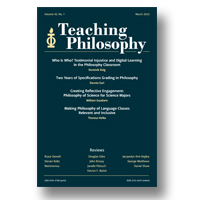|
articles |
|
1.
|
Teaching Philosophy:
Volume >
44 >
Issue: 1
Christopher Buckman
Including the Iroquois Great Law of Peace in Introduction to Political Philosophy
abstract |
view |
rights & permissions
| cited by
Introductory courses in political philosophy would benefit from the incorporation of material on the Iroquois Great Law of Peace, including the story of the foundation of the Haudenosaunee Confederacy. Classroom study of this tradition will serve several purposes: introducing a valuable account of political phenomena such as negotiation, consensus, veto, and rational communication; contributing to the diversity of syllabi; tracing the influence of Iroquois law on Western political institutions; and comparing the Haudenosaunee story to early modern social contract theory, especially Hobbes’s Leviathan. This paper draws connections to relevant topics in a standard, historically-oriented course and suggests learning resources and objectives.
|
|
|
|
|
2.
|
Teaching Philosophy:
Volume >
44 >
Issue: 1
Alexandru Manafu
An Experiential Education Approach to Teaching the Mind-Body Problem
abstract |
view |
rights & permissions
| cited by
This article shows how the mind-body problem can be taught effectively via an experiential learning activity involving a couple of classroom props: a brick and a jar of ground coffee. By experiencing the physical properties of the brick (shape, weight, length, width) and contrasting them with the olfactory experience of coffee (seemingly dimensionless, weightless, etc.), students are introduced in a vivid way to the well-known difficulty of explaining the mental in physical terms. A brief overview of experiential learning theory and its connection to philosophy is also provided.
|
|
|
|
|
3.
|
Teaching Philosophy:
Volume >
44 >
Issue: 1
Sarah E. Vitale, David W. Concepción
Improving Student Learning with Aspects of Specifications Grading
abstract |
view |
rights & permissions
| cited by
In her book Specifications Grading, Linda B. Nilson advocates for a grading regimen she claims will save faculty time, increase student motivation, and improve the quality and rigor of student work. If she is right, there is a strong case for many faculty to adopt some version of the system she recommends. In this paper, we argue that she is mostly right and recommend that faculty move away from traditional grading. We begin by rehearsing the central features of specifications grading and providing two examples of how to implement it in philosophy classes. In light of the examples, we argue that specifications grading fulfills two of Nilson’s central desiderata (increasing rigor and motivating students) but not the third (saving faculty time). Since specifications grading generates two benefits that when combined increase student learning, without adding or increasing burdens, we conclude that student learning increases when courses are revised to include aspects of specifications grading.
|
|
|
|
|
4.
|
Teaching Philosophy:
Volume >
44 >
Issue: 1
Mark Walker
The Skills-First vs. Content-First Philosophy Class
abstract |
view |
rights & permissions
| cited by
This paper offers a contrast between “content-first” course design, and “skills-first” course design. The traditional lecture format is a paradigmatic example of the former, by the later I mean courses that emphasize the sustained practice of skills integral to the discipline. Two arguments are offered for adopting, other things being equal, the skills-first design. One is the “content-plus” argument that the skills-first course design does a better job of promoting content acquisition than a content-first class. The second argument, the “skills-plus” argument, claims that a skills-first course design has the added value of better promoting philosophical skills as compared with a content-first course.
|
|
|
|
|
reviews |
|
5.
|
Teaching Philosophy:
Volume >
44 >
Issue: 1
Kelley Annesley
Ethical Issues in Women’s Healthcare: Practice and Policy. Edited by Lori d’Agincourt-Canning and Carolyn Ells
view |
rights & permissions
| cited by
|
|
|
|
|
6.
|
Teaching Philosophy:
Volume >
44 >
Issue: 1
Samuel Duncan
Doing Philosophy: From Common Curiosity to Logical Reasoning. By Timothy Williamson
view |
rights & permissions
| cited by
|
|
|
|
|
7.
|
Teaching Philosophy:
Volume >
44 >
Issue: 1
Michael Gifford
Thinking Through Questions: A Concise Invitation to Critical, Expansive, and Philosophical Inquiry. By Anthony Weston and Stephen Bloch-Schulman
view |
rights & permissions
| cited by
|
|
|
|
|
8.
|
Teaching Philosophy:
Volume >
44 >
Issue: 1
Amanda Hardman
Small Teaching Online: Applying Learning Science in Online Classes. By Flower Darby with James M. Lang
view |
rights & permissions
| cited by
|
|
|
|
|
9.
|
Teaching Philosophy:
Volume >
44 >
Issue: 1
John Kinsey
Buddhist Ethics: A Very Short Introduction (Very Short Introductions). By Damien Keown
view |
rights & permissions
| cited by
|
|
|
|
|
10.
|
Teaching Philosophy:
Volume >
44 >
Issue: 1
Gina Lebkuecher
Seeing Clearly: A Buddhist Guide to Life. By Nicolas Bommarito
view |
rights & permissions
| cited by
|
|
|
|
|
11.
|
Teaching Philosophy:
Volume >
44 >
Issue: 1
Corey McGrath
The Routledge Handbook of Philosophy of Colour. Edited By Derek H. Brown and Fiona Macpherson
view |
rights & permissions
| cited by
|
|
|
|
|
12.
|
Teaching Philosophy:
Volume >
44 >
Issue: 1
Thomas Schulte
Phronesis: An Open Introduction to Ethics. Edited by Henry Imler
view |
rights & permissions
| cited by
|
|
|
|
|
13.
|
Teaching Philosophy:
Volume >
44 >
Issue: 1
Rebecca G. Scott
Philosophy for Girls: An Invitation to the Life of Thought. Edited by Melissa M. Shew and Kimberly K. Garchar
view |
rights & permissions
| cited by
|
|
|
|
|
14.
|
Teaching Philosophy:
Volume >
44 >
Issue: 1
Adam P. Taylor
Salvation in Indian Philosophy: Perfection and Simplicity for Vaiśeṣika. By Ionut Moise
view |
rights & permissions
| cited by
|
|
|
|
